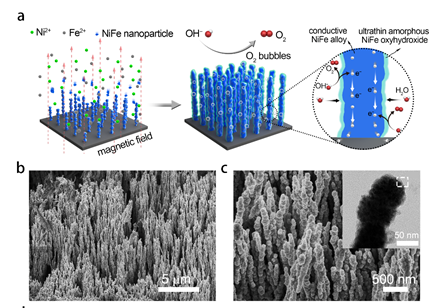The research group led by Yang Cheng, Associate Professor at Tsinghua SIGS published an article in Energy & Environment Science on 08 October, 2019. The paper, titled “Exceptional performance of hierarchical Ni–Fe oxyhydroxide@NiFe alloy nanowire array electrocatalysts for large current density water splitting” reported a super robust and highly reactive non-noble metal OER/HER electrocatalyst, which may represent a critical step towards an industrial electrolyzer for large scale hydrogen production.
Hydrogen is one of the cleanest energy carriers with high energy density and can be produced by water electrolysis, also known as water splitting -- a process that separates hydrogen from its strong bond with oxygen in water using a catalyst. However, the scarcity and high cost of noble metal based electrocatalysts, as well as the inefficient energy conversion of low-cost alternatives present major hurdles in the industry.
Yang's group developed robust NiFe nanowire arrays with the assistance of a uniform magnetic field. The in situ formed an ultrathin NiFe oxyhydroxide layer on the alloy nanowire surface and together with the fine geometry of the hierarchical electrode, substantially improves charge and mass transfer. In an alkaline electrolyte, this newly developed OER electrocatalyst can yield at large current densities of 500 and1000 mA cm-2 with excellent stability of over 120 hours.
Their work demonstrates that the electrode structure of inexpensive common non-noble NiFe materials can be designed to meet the industrial standard of alkaline water electrolysis and is meaningful towards practical and economic production of hydrogen by water splitting.

(a) Schematic of the synthesis of the NixFe1-x–AHNA nanowire array and its catalytic function for the OER. (b-c) SEM and TEM images of NixFe1-x–AHNA
This project was completed with the assistance of Professor Hong Jin Fan from the Nanyang Technological University. It was supported by the Local Innovative and Research Teams Project of Guangdong Pearl River Talents, Shenzhen Geim Graphene Center, the National Natural Science Foundation of China, Guangdong Province Science and Technology Department and AME Individual Research Grant.
In recent years, Yang’s research group has focused on the multi-physics-field-assisted (magnetic field, electric field, concentration field, etc.) fabrication of micro/nano metal structures and their structure evolution mechanism. These novel structures, including fractal dendrite-based silver, ferromagnetic metal/alloy nanowire arrays and a variety of complex periodic micro/nano metal structures, exhibit unique performance advantages and broad application prospects in the fields of energy storage, catalysis and electronics.
Article link: https://pubs.rsc.org/en/content/articlelanding/2019/ee/c9ee02388g#!divAbstract
Article by Liang Caiwu
Edited by Karen Lee


